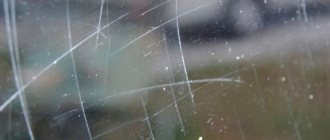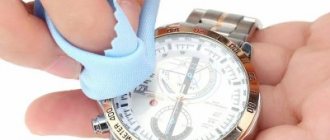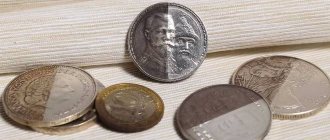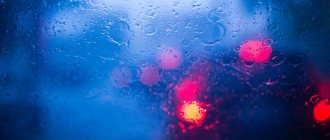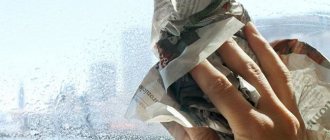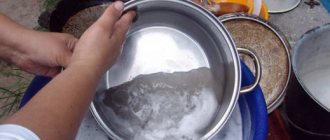Yesterday I accidentally came across an article about glass polishing, maybe it will be useful to someone)
During the operation of the vehicle, scratches constantly appear on the windshield due to sand, dust, and small pebbles. They get under the wipers and constantly scratch the glass, which is noticeable even to the naked eye. Pebbles from the road that fly out and land directly on the windshield cause the most serious damage to the car. This process cannot be prevented, but shallow scratches can be removed. After all, auto glass is necessary for the driver to clearly see everything that is happening on the road. Therefore, improper care of glass not only leads to damage, but also poses a safety risk for both the driver and the passenger. Many people use toothpaste to grout small scratches. This is a very old way. You just need to apply toothpaste to the scratch and let it dry. Then wipe the surface with a soft cloth. But it’s better, of course, to use professional tools.
ORDER OF WORK
Surface preparation. Before you can get rid of scratches on your car, you need to prepare the surface to be treated. You need to rinse it thoroughly and dry it. Then identify the areas that need polishing. They must be identified visually. For a more thorough examination, you can run your finger across the glass. Where the skin clings to the scratch, it is better to mark it with a marker. You need to take a clean cloth and glass cleaner. Soak a cloth in warm water and rinse the glass thoroughly. Then wipe everything dry. Next, apply glass cleaner to the sponge and thoroughly clean the glass with it. As a final touch, wipe everything down with a dry, lint-free cloth. Next, you need to protect the interior and body of the car from contact with cleaning agents. In order not to stain the car body, it is necessary to completely cover it with film. A cutout should be made on the windshield and secured with tape along the edges of the resulting window. Necessary equipment. Also, before removing scratches from the glass, you need to prepare the tool. This could be a professional polishing machine, or if you don’t have one, then a simple drill with a circular attachment made of fabric (felt) attached to a chuck will do. A grinding machine will not work in this case. It is best to use a polishing wheel rotation of no more than 1700 rpm. Professional tools are best used by those people who are confident in handling them. Otherwise, you can easily deform the glass, even to the point of a lens effect. You should purchase pastes and masking tape in advance. You need to work in gloves, a mask and a respirator, and special glasses.
Polishing. Produced with a special paste. It is applied to scratches and polished the surface using a soft felt wheel. If you polish the scratches, the glass will become cloudy and at the same time change its color. Not very deep scratches can be repaired with wax or paraffin. You just need to apply them to the scratch and rub thoroughly with a dry cloth. The polishing process begins by applying paste or polish to a piece of glass or a nozzle. There is no need to cover the entire surface with paste at once, as it dries and loses its elasticity. After the paste is applied, the cleaning process itself begins, which should be smooth, without pressure. You also need to monitor the temperature of the glass, otherwise heating it can lead to an increase in cracks. To reduce the temperature, it is best to use a household spray bottle. It can be used to feed into the polishing zone. The polishing area must be limited with tape and the tool must constantly move without stopping. Washing. It is necessary to wash off with cold water all the remaining abrasive substances remaining from the polishing paste. Remove the tape and film from the car. You can wipe the entire car with a damp and dry cloth and evaluate the overall condition of the repaired areas. If there are any shortcomings, defects, or clouding, then it will be necessary to repeat the glass cleaning procedure. If everything was done wisely and correctly, then the effect should be simply excellent. It should be noted that regular polishing cannot remove large cracks. It seems that everything is easy and simple. However, it is not. Grouting scratches is a long, labor-intensive process and you should be patient. There are special ointments and pastes to remove minor scratches. For example, GOI paste is made on the basis of chromium oxide and is used for polishing and cleaning steel alloys and glass. However, it will leave a cloudy trail. You should try not to overdo it while sanding with this paste. If you press it too hard, you can cause even more damage to the car. If a fine spider web of scratches appears on your car glass, you can polish it with diamond paste. Scratches from windshield wipers can be rubbed off with CD polishing paste. But it is better to ask the master which paste to choose, since its different variations have different grain sizes.
GOI paste: what is green mass?
The name stands for: State Optical Institute. This is where this cleaning material was created in the 30s. last century. It looks like a greenish mass, sold in the form of a smooth block and in a sealed jar.
Read also: Why do animals need water?
Composition of the cleaning product
The main component in the composition is chromium oxide. The grain size of the preparation and its characteristics directly depend on its concentration. The higher the percentage of chromium oxide, the rougher the composition (variation can be from 60 to 85%).
Important! The green mixture is harmless to humans due to the fact that 3-valent chromium oxide is used in its creation, and only 6-valent chromium oxide is harmful. However, it is recommended to wear safety glasses and a mask when working, because when using it, dust appears that irritates the human mucous membranes.
Chemical composition
The material is made in the form of rectangular bars of green color with a dark or light shade. The main components are chromium oxide, various binders and other additional components. Depending on the type of paste, the main abrasive makes up from 65 to 80 percent of the total volume. In addition to bars, the paste is produced in plastic containers and as an impregnation for felt circles in ready-made form. The soft circle is supplied for sale already impregnated with the required amount of GOI paste and is ready for use.
You can also determine the composition of the paste by its color. The more chromium oxide in its composition, the lighter it is and is characterized by higher abrasive abilities. The darkest, almost black paste with a green tint is used for fine polishing and imparting a mirror shine to surfaces, while the lightened one is used for rough grinding.
Benefits of polishing
Any job has its advantages and disadvantages. Polishing with GOI paste will make you move a little and even sweat, which is good for the health of every person. The cost of this DIY work is cheap - you only pay for the paste and circles. Communicating with technology, acquiring new skills and enjoying the results of your work - all this will benefit you!
The estimated cost of this product is 230 rubles per kilogram. Many people may have pieces of GOI paste in their sheds and garages since the times of the Soviet Union. It is more profitable to buy a large volume, the price is cheaper.
Headlight treatment
Polishing headlights is not fundamentally different from polishing other elements. Before processing, the headlights are washed. You will need WD40 lubricant. It, together with the paste, is applied to a polishing wheel made of felt or felt. The grinder (drill) should have a speed within 1000. Do not put pressure or force on the surface being treated. After two passes, the headlight takes on an almost perfect appearance. Then they start processing with polish. You can carry out the entire procedure manually, but then it will take not ten minutes, but at least an hour.
The subtleties of polishing a windshield
Polishing the windshield with GOI paste will help remove minor scratches, dirt and other unwanted elements. But this method will not work to eliminate cracks and chips. The process of polishing a windshield involves removing a very thin layer from the surface. It is better to do this using a polishing machine. If it is not there, you can use an electric drill at low speeds, using a special attachment. It is highly undesirable to use a grinder - its high speeds can overheat and destroy the glass. Parts adjacent to the glass should be sealed, preferably with film.
It is advisable to first outline the most problematic areas with a marker; this will reduce the amount of empty work. The paste is applied both to the circle and to the glass. The polished surface must be constantly wetted. After completing the work, it is important to thoroughly wash the glass and remove any remaining paste. The last stage is processing with pastes without abrasive. They are also applied to rags. Polishing should not be frequent, otherwise the glass will acquire a lens effect. Glass with large scratches can be maintained in better condition using this method, but not for long. Over time it will have to be changed.
How to use GOI?
The principle of operation of this polish is based on the careful removal of the top layer, which contains scratches and abrasions. This should be done with a soft cloth soaked in gasoline. Gasoline is needed to dissolve too large pieces.
Advice! If you don’t have a car and you don’t know where to get gasoline, you can drain it by carefully opening a gasoline lighter.
- Before use, you need to wipe the paste a little on a piece of unnecessary metal.
- If large pieces remain in the paste during use, you can achieve the opposite result - scratching the surface.
- Polishing is a delicate process in which details matter. The paste should be kneaded and the cloth should be as soft and smooth as possible.
- You can take a polishing wheel and apply GOI paste to it, but under no circumstances should you start polishing by applying the paste to the surface itself. The product can be lightly lubricated with liquid oil – “spindle”.
Can GOI cope with deep defects?
The paste copes with fairly severe scratches, if the thickness and strength of the material allows. You need to use all four stages of polishing, and then rinse the object with carp. Pharmacy kerosene will do. If you don’t have one or the polished item cannot be treated with kerosene, running water will do. This will wash away microparticles.
Polishing car parts
Polishing and grinding car parts is important not only for the sake of excellent appearance, but also to protect against rust and further damage.
Scratches appear on the headlights, which makes them dim; the paintwork rubs, damage begins to threaten the body; The dashboard loses its appearance due to scratches. Green paste and its followers are suitable for plastic, glass, paintwork and metal.
Information! Grinding and polishing are two sides of the same process. Sanding is a rough procedure using an abrasive to remove the damaged layer. Polishing – softly bringing an object to a shine. It usually follows after sanding. Glass surfaces of a car, be it headlights, rear-view mirrors or windshield, are polished with flannel. It is easier to work on the body with felt.
For headlights and other glass products, the following algorithm is suitable:
- Start by degreasing the surface: wash with car shampoo, wipe with alcohol or glass cleaner. If there is even a little dirt on the glass, it can cause additional scratches.
- Polishing should be done with a drill with a felt attachment or a special grinding machine. Manual work is only needed to remove the dullness; otherwise, you can’t do without a special device.
- To polish, add a drop of machine oil to the GOI paste and apply the mixture to a polishing wheel.
- Without unnecessary pressure, treat the desired areas, or carefully go over the entire surface of the glass.
- Polishing movements can be made in any direction, but it is better to use the principle of overlapping stripes.
- To control the result, wash the GOI with a paper napkin: when the surface has become perfectly smooth and transparent, you can complete polishing.
- When polishing a single part, it is better to cover the entire remaining surface with film, otherwise you will then need to wash the entire car.
- It is better to fill any deep scratches with a special transparent compound.
- For glass, only GOI No. 1 or 2 can be used.
- The glass may become hot during friction. This must be carefully avoided, as unevenly heated glass can crack.
The body is polished in the following sequence:
- Clean the surface to be treated thoroughly.
- Apply paste to the wheel and accelerate the machine to 1100 rpm, then grind the body at a slight angle.
- Rinse off any remaining product with low pressure water.
Is GOI suitable for jewelry?
Polishing jewelry with GOI paste is the same as any other. You just need to take paste No. 1. Gold and silver jewelry can be polished well using this method.
The only difference is that they require special cleaning. Silver should be treated with toothpaste using a brush. Then you need to boil it in an enamel bowl with ammonia and soap shavings. To use knife paste, it is applied to a leather belt stretched over a block of wood.
No matter how versatile GOI paste is, there are surfaces that it is better not to touch. Do not use on watch glass or other metal parts. A mechanical watch is a thin and fragile mechanism. Soft versions of the paste do not give a good result on the watch, and rough ones will simply erase the coating from the metal. If the watch is covered with sapphire glass, then there is no point in polishing for another reason - this glass is so hard that it cannot be polished with paste.
"Ambulance" for the windshield - what can be done in the garage?
The easiest way out is to buy a new windshield. True, after some time the same fate awaits him as his predecessor. Typically, a windshield lasts for six months, after which a telltale network of scratches begins to appear on the surface. And it is unlikely that there will be a driver in his right mind who will spend a lot of money on purchasing new glass when the old one is intact.
The glass polishing procedure is a much more acceptable option, but you already know its disadvantages, to which you can also add a fairly high cost. Again, the effect will be temporary - good polishing lasts for a maximum of a year. Liquid glass polishing is a relatively new type of service in which a special polish is applied to the glass and surface, which, after hardening, forms a polycarbonate film that repels dust, dirt and water. The cost of the polish itself and the services of the craftsmen will cost a decent amount, although you will not damage the glass itself, and the effect will last quite a long time.
For which products is GOI paste not suitable?
Goi paste is not suitable for processing all products. Some are prohibited:
- Gold-plated products - under the influence of the product, the top layer can be erased, which is the main value.
- Steel and nickel - they are processed using a special device, and not manually.
- Metal watches - polishing is possible only if the mechanism is removed; otherwise, Goi paste is not used for them.
- Sapphire glass – polishing will not provide the desired result; these items cannot be polished.
It is recommended to wear safety glasses and a mask when working, because when using it, dust appears that irritates the human mucous membranes. Only if the abrasive is used correctly will it provide a shine effect. Otherwise, time will be wasted, and irreparable damage may be caused to the product.
Polishing the surface at home is easy. It is only important to follow the general advice and not spoil the fabric being processed.
Cleaning products using GOI depending on the material
The use of polishing compound depends on the type of material.
General principles of cleaning with GOI paste
Polishing the surface at home is easy. It is only important to follow the general advice and not spoil the fabric being processed. The product is used in the following sequence:
- To prevent scratches on the surface, take a piece of rag and soak it in gasoline.
- It is necessary to spread a little green mixture on a rag and wipe it on an unnecessary object made of metal or glass. This will cause excessively large crystals to disintegrate.
- Rub the desired area with light movements without pressure until the body becomes shiny. This treatment will only take 3-4 minutes. It is only important not to scratch the treated area with large particles.
- After finishing the processing, you need to walk over the sanded object one more time with gasoline or immerse the entire product in kerosene.
Metal processing with GOI paste
Before using GOI paste, it is important to decide on the type of metal. For example, silver cutlery (knives, spoons, forks) turns green over the years and requires high-quality cleaning. In order not to accidentally spoil expensive material with roughness and scratches, perform cleaning according to the following scheme, variety No. 3:
- Wash all necessary silver utensils under running water.
- Rub with a soft toothbrush and detergent.
- Separately, pour a glass of water into the saucepan, adding a spoonful of ammonia, a pinch of laundry soap and a whisper of washing powder.
- Boil the appliances in this composition.
- Rub a piece of felt with a bar of paste and treat the utensils. Then take a softer cloth and sand each spoon for a few minutes.
Read more about other silver cleaning methods here.
- Speaking of other metals, goyi is used with great success for knives, drills and other tools. Cleaning of metals is carried out according to the above scheme.
- To polish a watch, you must first remove the watch mechanism.
- Gold is cleaned with flannel or a piece of leather with mixture No. 1 applied. Try to apply without pressure so as not to damage the soft precious metal.
Important! Remember to always apply polish to a cloth or sanding wheel, not to the workpiece. This will prevent unsightly scratches from appearing.
Article on the topic: Methods for cleaning gold.
Video: Cleaning a coin with GOI paste
Processing your phone or tablet screen
To polish the screen of a mobile phone or tablet, you need composition No. 2 and a flannel rag.
Cleaning involves the following steps:
- Apply a thin layer of the green preparation to the flannel.
- Pre-rub any unwanted metal or glass surface with it to remove abrasives.
- Rub the display with light movements without pressure for 5 minutes, be careful when working with a fragile product.
- Remove any remaining product with a clean, dry cloth. The screen will be rubbed until it shines.
Important! The product for plastic is used in the same way as for glass.
Precautionary measures
At the beginning, we mentioned that GOI paste is not currently produced in Russia due to its toxicity. However, it is sold freely in stores whose owners were able to supply the well-known polish. And if a person purchases this remedy, he should know some precautions in order to avoid tragedy.
- You need to use GOI paste extremely carefully, avoiding contact of its particles with the mucous membranes of the eyes and nose. If you are unable to protect yourself from this, immediately rinse the affected surface with running water and call an ambulance.
- Use a respirator or at least a medical mask when working with polish, especially when polishing metals using a cloth soaked in gasoline. You should not expose your body to the risk of poisoning from vapors of chemically complex substances.
- Keep children away from polish storage areas.
- Work with the product while wearing gloves to protect the skin of your hands.
So, GOI paste is an effective, but unsafe remedy. Even if you have used it for polishing many times, you should always be on guard when working. If the situation allows, it is better to use more gentle methods.
Types of GOI paste
The typology of the product is divided into fine, medium and coarse, which are further subdivided into two varieties. There are four types. Their division is based on abrasive substances that have their own parameters. Each person has their own special number:
- No. 1 – has a black color with a greenish tint. Used for final polishing. The main task is to give the processed object the necessary shine. Chromium oxide is 70%, sodium bicarbonate is 0.2%, silica gel is 1.8%, kerosene is 2%, fat is 10%.
- No. 2 – has a dark green tint. Operation consists of gentle polishing to give the product a shine, as in the first option. Fat also makes up 10%, chromium sesquioxide - 74%, kerosene - 2%, silica gel - 2%, sodium bicarbonate - 0.2%.
- No. 3 – the color is completely emerald without any impurities. Made to produce a medium grind. Thanks to it, the surface becomes perfectly clean and begins to shine evenly. Kerosene and silica gel make up the same amount - 2%, chrome greens - 70%, fat - 10%.
- No. 4 – light green tone. Leads to leveling out the smallest and most imperceptible scratches that may remain after using abrasives. Designed for the roughest sanding. Chromium oxide occupies 85%, stearin – 10%, fat – 5%, silica gel and kerosene 2% each.
Appearance
GOI paste is light green or dark green bars consisting of abrasive chromium oxide powder, organic (fatty) binders and auxiliary substances (activating and intensifying additives). GOI pastes are produced both in the form of bars and in the form of soft (felt) polishing wheels already impregnated with paste.
They are a mixture of chromium oxide (gives a green color, the shade of which depends on the percentage - 65-80%), as well as solvents and chemical reagents - kerosene, stearin, silica gel and others. There are 3 main grades of GOI paste: coarse (No. 4), medium (No. 3 - the most common) (visible in the photo) and fine (No. 1 and No. 2).
Coarse has a light green color, is most effective in terms of the volume of material removed, and gives a matte surface. The middle one has a thick green color and gives a clean surface.
Thin pastes are dark green and black with a greenish tint, respectively; they are used for fine grinding (finishing) and impart a mirror shine.
What is needed to polish car rear and windshield windows with your own hands?
To remove scuffs, you will need certain materials, as well as tools that are not professional. This set will be enough to get rid of micro-scratches and return the glass surface to its original appearance, here is its list:
- polishing powder or paste;
- polishing machine or drill with speed controller;
- felt polishing wheel; an electric drill requires a mandrel or attachment to install the wheel;
- polyethylene film to protect the body from dust;
- tape, marker, napkins, spray bottle and solution for cleaning glass surfaces.
Knowledgeable craftsmen assure that using an angle grinder as a polishing machine is extremely undesirable. Their lack of a speed controller can lead to overheating of the working surface, which leads to irreparable defects when polishing car windshields and rear windows with your own hands. Special grinders require water supply to cool the process.
Polishing materials
ushm
When performing work, preference is given to polishing pastes with fine abrasives; they do not scratch the surface. Liquid materials are used in mechanical processing with a continuous supply of working suspension. In the case of manual or semi-mechanical work methods, hard pastes are usually used. It is also possible to use powdered formulations, which are diluted with water to a creamy state before performing work.
Some materials are produced on the basis of powders of natural origin. But the bulk of modern polishing pastes include synthetic components: oxides of cerium, zirconium and thorium. Popular and proven materials include the following:
GOI paste - how to use?
All-purpose cleaner can be used as follows:
- Take a soft cloth (flannel will do). Soak it in gasoline.
- Apply the paste to the fabric and rub it on a metal or glass surface that is not related to the product being polished. This is necessary so that the grinding paste with large particles does not scratch the desired surface.
- Next, when the cloth with polish is ready, you can begin processing the product. This should be done without much effort, gently rubbing the desired area with a cloth until a shine appears.
- After finishing work, the workpiece must be wiped with gasoline or immersed in a solvent to remove any remaining paste.
How to polish metal with GOI paste?
Depending on the type of metal, cleaning with GOI paste varies. For steel products, special devices are used, but it is better not to clean gold and precious metals with this paste, as there is a risk of removing the top layer. Very often, GOI paste is used for silver cutlery. Let's take a closer look at how to polish silver with GOI paste:
- To begin with, silverware should be thoroughly cleaned with tooth powder.
- Then, in an enamel saucepan, mix a spoonful of grated laundry soap and tooth powder, as well as a couple of drops of ammonia in water. Place on the fire and when the solution boils, dip the products into it.
- Remove silverware and rinse in cold water.
- After drying, polish with GOI paste No. 1 or No. 2.
How to polish glass with GOI paste?
Many car owners know the wonderful properties of GOI paste and use it to remove minor scratches on car windows. To do this you need:
- Wash the glass with car shampoo, soapy water, or wipe with an alcohol-containing detergent, and dry.
- It is advisable to carry out glass polishing work with a special machine, and manually only remove the dullness.
- Mix gasoline with the paste at the rate of a drop per spoon of GOI paste.
- Place the resulting mixture on a polishing wheel and carefully work the desired area of glass.
- The polishing paste is applied according to the principle of overlapping scratch stripes.
- Polishing work is completed once the glass is smooth. GOI paste No. 1 and GOI paste No. 2 are suitable for such work.
How to polish plastic with GOI paste?
Plastic parts become scratched and dull over time. Polishing with GOI paste can restore the original shine to such surfaces. The sequence of actions is the same as for polishing glass:
- The surface is degreased and dried.
- Apply gasoline or motor oil to the felt circle of the machine or soft flannel or cotton fabric, mixing it with the paste.
- Gently rub the resulting mixture onto the plastic, periodically wiping off excess paste.
- Wash off the residue with gasoline or kerosene.
Technology
Any polishing job begins with a thorough wash. It is necessary to wash and remove not only dirt, but also all possible particles embedded in the surface. They use not only water, but also detergents and chemicals. Drying follows after washing. It is important to carry out the work in warm weather, indoors. The room must be ventilated, free from dust and direct sunlight.
After cleaning, a felt circle comes into play, onto which abrasive is applied. In this example, GOI paste. Polish in a circular motion until the desired result is achieved. During the operation, the surface to be treated must be regularly wetted with water. Working “dry” is strictly prohibited, otherwise we will get a scratched, terrible surface. The success of the work will depend on the volume of liquid and paste.
The principle of the “golden mean” works. Too much water will wash away the paste and the abrasive particles will not be able to firmly touch the glass. A large mass of paste will not give a mirror surface, but a matte one. To polish car windows, GOI paste is used, which can remove a layer of material less than 1 micron. This is GOI paste with brand “1”. For insurance, to avoid damage to the coating, a drop of vegetable oil is added to it.
This mixture is heated and stirred - the procedure significantly softens the activity of the abrasive. To remove large defects on glass, several polishing approaches can be applied. Initially, use brand “4” paste, and then move on to brand “1”. The ideal can be achieved only with the finest abrasive. You can see the features of polishing with GOI paste in the following video:
Is it harmful to humans?
They constantly write on the Internet that Goya paste is toxic and harmful to the human body. This is due to the fact that it contains chromium oxide.
However, based on chromium itself, this substance can be different. Bivalent and tetravalent are black, trivalent is green (this is what is used in the paste), hexavalent is dark red.
The latter is poisonous, as well as all its compounds. Trivalent is non-toxic and completely safe.
This statement was confirmed by the State Sanitary and Epidemiological Expertise.
Rub the desired area with light movements without pressure until the product begins to shine. This treatment will only take 3-4 minutes.



